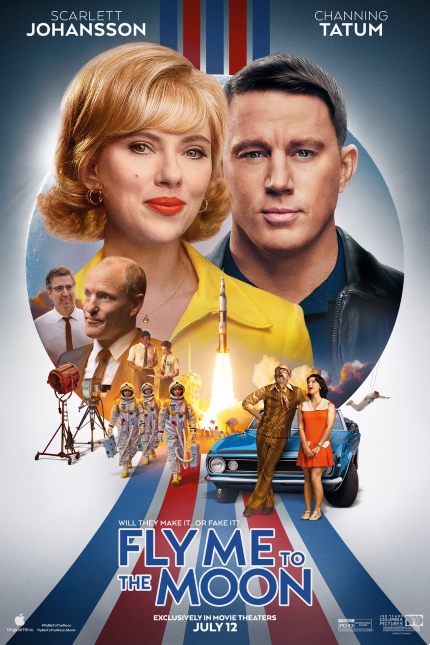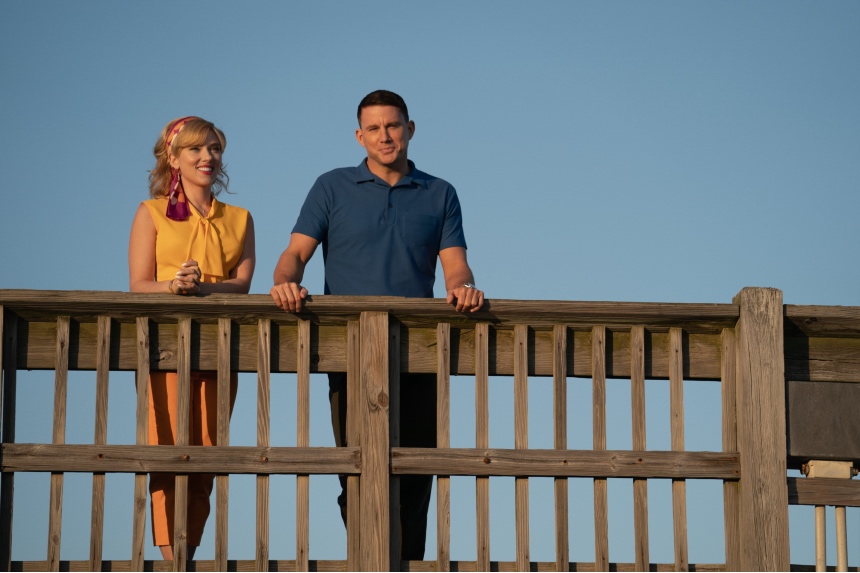FLY ME TO THE MOON Review: Landing Among the Stars
Scarlett Johansson and Channing Tatum star in director Greg Berlanti's flighty comedy.

As many of us bemoan the relative dearth of romantic comedies Hollywood is offering up these days, studios have countered with a new trend in a bid for wider appeal: the romantic comedy + X.
Earlier this year, in The Fall Guy, X was a meta-action mystery; with Fly Me to the Moon, X is a good old fashioned space race drama.
And like The Fall Guy, Fly Me to the Moon manages to successfully weld together its component parts to deliver something surprisingly lovely.
Scarlett Johansson and Channing Tatum bring their natural charisma and an almost giddy chemistry to the film; while the two have never shared the screen (despite appearing in the same films) they have an almost Spencer Tracy/Katharine Hepburn-like familiarity. Though perhaps the more apt comparison is Doris Day and Rock Hudson, given the film's 1960s period-setting and Johansson's vibrant pastel costumes. Then there's also the Lover Come Back advertising tie-in.
Following in Lover Come Back's footsteps, Fly Me to the Moon offers a battle of the sexes comedy with rivaling philosophies of how to properly convince people of your cause. Johansson's Kelly, a New York advertising agent who's brought to NASA to bring the public and several key politicians back on board the once exciting mission to place a man on the moon, is a master manipulator, crafting just the right lies to get what she wants. Tatum's Cole, the launch director for the Apollo 11 mission, has a strict honesty policy and is regularly shocked by Kelly's actions.
In their attempts to lobby various senators to their cause, the two regularly butt heads, especially because Kelly's manipulations are often far more successful. But in what may be the film's best scene, Cole makes an genuinely impassioned case to a conservative Christian senator that science is not at odds with faith and the work done at NASA brings people closer to the divine around them, not further from it.
The monologue also functions as a thesis statement for the film's aesthetic treatment of space exploration. Oscar-nominated cinematographer Dariusz Wolski brings the eye that's made him Ridley Scott's go-to DP since Prometheus, and it's easy to see (literally) why director Greg Berlanti brought him on for a movie about the wonder space can inspire.
As with any great image maker, Wolski makes scenes in motel rooms, offices, and construction warehouses just as beautiful as the images of the wide open sky. Daniel Pemberton's classical score bolsters these images, swelling at just the right moments for both the marvel of space and the romantic heart of the movie.
Berlanti and editor Harry Jierjian maintain a balance between that awe, the big emotions of romance, and the lightness of a studio romantic comedy through a delightful editing style that relies equally on wipes and match cuts segueing from archival footage into the world of the film. Add in some splitscreen montages and a just shy of chaotic tracking shot combined with a timelapse, and Fly Me to the Moon establishes itself as one of the most visually engaging major release films of the decade (and make no mistake, with a budget of of $100 million, the film is a major release).
Even at its slightly too long two hours and ten minutes, Fly Me to the Moon is a wonderful reminder that, every so often, swings for a four quadrant hit can knock it out of the park, and in this case, into the stars.
The film opens Friday, July 12, only in theaters, via Sony Pictures Entertainment. Visit the official site for locations and showtimes.









